 |
A Little About Me |
Hi, my name is John and if you have the time I think
you will enjoy reading a little bit about a former action guy. After high
school I spent twenty-three years in a wild occupation that continuously placed
me in strange situations and circumstances. The participating in being there
doing of this occupation often required me and others to face hardships and
dangers. For twenty-three years I was a United States Air Force Pararescueman.
Most of the rescue missions I participated in being there doing have gotten little public attention. However, my participating in the rescue of the crew and passengers of the luxury cruise ship the MV Prinsendam during October 4th and 5th, 1980 has become much written about event. Published in 2006 is the book "Burning Cold-The Cruise Ship Prinsendam and the greatest sea rescue of all time". This book written by H. Paul Jeffers and was published by Zenith Press in 2006 (ISBN-13:978-0-7603-2079-2).
In the months following the greatest sea rescue of all time a Search and Rescue case study was accomplished by the Seventeenth Coast Guard District. This study was completed February 3, 1981. Rear Admiral Robert J. Knapp, Commander, Seventeenth Coast Guard District wrote "The training and expertise of the Air Force pararescuemen was responsible for the survival of passengers in the last lifeboat. It is notable that we were forced to rely on another agency to provide these personnel. I recommend we develop a similar, highly-trained, well equipped rescue elite."
This recommendation predates by two years the February 12, 1983 sinking of the S.S. Marine Electric which is the tragic event credited with the establishing of the U.S. Coast Guard Helicopter Swimmer program. It wasn't until March 5, 1985, almost five years after the greatest sea rescue of all time that the U.S. Coast Guard had its first operational unit with helicopter rescue swimmers assigned. Official Coast Guard press releases and histories concerning the conception and makings of its Helicopter Rescue Swimmer Program tend to overlook what truly is the greatest air-sea rescue of all time.
The M/V Prinsendam maritime rescue lists second among
the top ten rescues of all
time the Coast Guard accomplished between 4
August 1790 and 4 August 2007. The only top ten Coast Guard rescues making the
list having Coast Guard helicopter rescue swimmer participation is Hurricane
Katrina. The Air Force had its rescue aircraft, helicopters and Pararescuemen
jointly involved in getting both M/V Prinsendam and Hurricane Katrina missions
done. Most discussions of both rescue operations often fail to disclose USAF
Pararescuemen were doing rescue swimmer and other rescue duties from helicopters
and by parachute from aircraft since 1947 (about 37 years before the Coast Guard
Helicopter Rescue Swimmer program was established). By 1964 it had become a
nothing special everyday event to parachute Pararescuemen from rescue aircraft
250 and more miles out at sea to provide emergency medical life saving treatment
to critically injured crew and passengers on military, merchant, and privately
owned ocean going vessels. 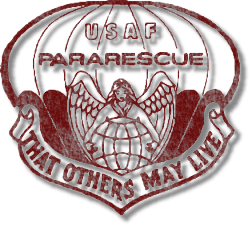
If you
are interested in learning more
about my former profession, then a
visit to the following web sites is highly recommended.
Specialtactics.com
is the site to visit if
you are considering an enlistment in one of the
American
Armed Forces. This is a must visit site if you are planning on becoming an Army Ranger, Marine Recon,
or Navy Seal. It allows you to examine the USAF combat rescue and special operations community
by providing an unsurpassed collection of non-Hollywood
documents and links. The USAF Pararescue Association is a non profit organization
whose members consist of the family and friends of Pararescuemen, and the Active Duty,
Guard, Reserve, and Retired Pararescue Specialists who have served their country
since 1947. PJs in Vietnam is the story of air rescue in Vietnam as seen from the eyes of its pararescuemen.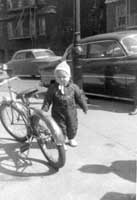
Although I was born in The Bronx, most of my formative years (7-17) were spent living in rural Orange County New York about 50 miles north west of New York City.
For a few years between the ages of about 5 years and 7 years
my family lived in
Merrick
Long Island. The move to Long Island was the result of my father
changing employment from IBM to the Atomic Energy Commission's
Brookhaven National Laboratory.
It was my father changing employment from the Atomic Energy Commission to work
for New York University as a research and
development design engineer at NYU's
Research Department of
Environmental Medicine that caused the move first
to Laurel Ridge,
Sterling Forest and then to
Monroe, New
York.
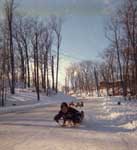
Laurel Ridge was home for about five years. Development
of this community began in 1956 when 8,000 acres of land belonging to Sterling
Mine and Railroad was sold to City Investing Company (now
Sterling Forest
LLC). The first ten model homes were opened for sale in October 1961.
The development of this residential neighborhood ended with only 143 homes on
half acre or one acre lots being built. The picture to the left is me
sledding west down Fawn Hill Road from the T-intersection of Deer Path Road.
The picture below is our former Laurel Ridge Road home on Deer Path Road as it looked in 1983.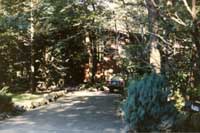
Other development on this tract of land include the 125 acre Sterling Forest International Gardens and Ski slope (now Tuxedo Ridge and New York Renaissance Faire), Union Carbide Sterling Forrest Nuclear Research Center (subsequently bought by Cintichem, a subsidiary of Hoffmann-LaRoche a 5kw research nuclear reactor in operation from 1961 to 1990 has been decommissioned and dismantled), International Paper, International Nickel, Xicom, Wehrem Enviro Tech, and NYU's Research Department of Environmental Medicine. However Sterling Forest never became the envisioned place where scientists, teachers and students would be able to live, work and play. Continued development in Sterling Forest never met its expected level of growth primarily because of its isolation from retail shopping, entertainment establishments, schools and the high costs of building on the steeply sloped land, marshy swamps and other unbuildable acreage. Some of the industries such as International Nickel and Cintichem have since moved out.
Our family
was among the first to move to Laurel Ridge. I was about ten when I
started a paper route delivering the
Times Herald Record
every morning. At the time the Long Meadow road to NYU's research facility
was unpaved dirt road for half of its length. A state game warden lived in
a house where the pavement ended. Driving this was 3 to 4 miles, but going
through the woods on game trails the direct line distance was about 2-miles.
During the winter months my dad would drop off the paper, but in the summer I
often walked the game trails to deliver the paper.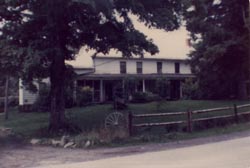
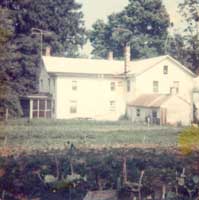
Whatever the reasons, my parents decided to move out of Sterling Forest. By the summer of 1968 we were living in a large old house in Monroe New York. The house was about 7.7 miles from Laurel Ridge and its location kept us children in the Monroe-Woodbury Central School District.
The exact date this house was built is unknown, but the date
used is ca. 1810. A Hagstrom's map of Orange County (ca.1930) shows the house
we moved into being on a 108 acre property owned by Thomas Caren and the house
remains known as the Caren House. Its history includes being a rest stop
for the stagecoaches in the 1800s.. Probably for the
stage line of Anthony
Dobbin that had a route that ran from New York City to Albany. I do
not know when Orange Turnpike (Orange County Road 19) was built, but I do know
the first turnpike in Orange County, the Orange Turnpike was chartered in 1800.
Some sort of trail certainly preexisted the 1800 charter. Records are
unclear, but Orange Turnpike was subsequently probably part of the auto trail
system known as the Liberty Highway (predates 1924) that connected New York City
to Cleveland Ohio. There is little doubt the private ownership history of
the property extends back to at least 1741 as when my parents bought this
property the right away owned by the state or county for Orange Turnpike was
only the width of the pavement and for about 100-200 foot length of the road my
parents owned the land on both sides. The picture below-left shows the
part of lot on the opposite side of Orange Turnpike.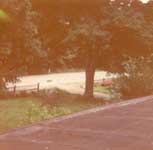
Local history of Village of Monroe indicates European settlement of the area began about 1741. There is a water filled mine shaft about one mile south of the property and the records Sterling Mines and other iron mines in the area indicate mining operations began about1752. The iron chain put across the Hudson River at West Point to keep British war ships from going further up river during the American Revolution (1775-1783) was mined and forged by the Sterling mines. The iron industry in the area declined after the American Civil War (1861-1865). Dairy consumables gained access to New York City markets when the Erie Rail Road brought better, faster, and more reliable personal and commercial transportation to the area in 1841.
There is no record of when the oldest part of the house was built, but it is known the Caren family built additions as the family grew. The house was turned into a Bed and Breakfast by subsequent owners and in addition to significant modernization renovations another addition to include a garage was built. 1810 is used as the exterior construction is similar to other houses in the area known to be built around 1810. The basement received extensive concrete renovation after my parents sold it, but when we lived there it was a stone floor and the wall was stone that was laid without use of any cement to include the fireplace that was also in the basement. The house had five fireplaces.
The agriculture and dairy farming that was prevalent in the
local area when I was growing up have disappeared. When we moved into this
house there were about 120
working dairy farms in the
local area.
All the farms have been sold and the pastures and fields are now filled with
houses. The farm fields on the opposite side of Orange Turnpike from this
house have become a suburb and a
golf course.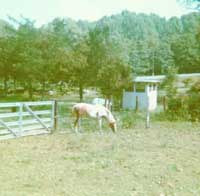
Us children believe our parents bought this house just to keep us kids busy doing chores while we were teenagers. We had several acres and a pond to maintain. Since power mowers had been perfected and because grass didn't require mowing every day we were drafted into doing other work. We grew vegetables, raised chickens, and kept several dogs, a horse and a cow. On weekends we would place a stand on the side of the road (Orange Turnpike) in front of our house and sell what we had raised and produced. We sold bait fish (I had stocked the pond with them), various vegetables, and eggs. I also trapped muskrats, skinned them and sold the pelts for two to three dollars per pelt a pelt.
All these chores must not have kept me too busy as my brother and I started paper routes for the houses on Stage and Still Roads (about a two mile walk every morning). These two routes were taken over by my younger brothers and sisters when I turned sixteen My brothers and sisters kept these paper routes until about 1980. Until age sixteen I also caddied at the Monroe Country Club which was about a mile from the house.
The second summer while living in this house I worked at a local auto repair and gas station. The third summer I worked in a commercial laundry that did all the bed sheets, curtains and other laundry for the local hotels, summer camps, and hospitals. At the end of the third summer at got a permanent part time job as a retail clerk at the newly opened local ShopRite Supermarket. I worked there after school and on the weekends my senior year of high school.
I graduated high school at age 17 in June 1973. On 10 July 1973 I reported to Air Force Basic Military Training. After completing Basic Military Training the Air Force sent me to all four corners of the globe and many points in between. We are back to where my story started of after I graduated high school I served twenty-three years as a United States Air Force Pararescueman. Is there more to my story? Yes, but you will have to wait for either the book to be written or the movie to be made. I will however say that after bouncing around the world for 23 years I decided to set roots in Anchorage, Alaska.
Education
Candidate for B.A. Mathematics with minors in Computer Science & Philosophy, University of Alaska at Anchorage, temporarily on hold.
B.S. Vocational Education with education, training, and development specialization, Southern Illinois University at Carbondale, 4 August 1990.
A.A.S. Instructor in Technology, Community College of the Air Force, 16 January 1990.
A.A.S. Survival and Rescue Operations, Community College of the Air Force, 30 January 1985.
Military Awards and Decorations
| Distinguished Flying Cross with Valor Device (Heroism) | Meritorious Service Medal (2) |
| Air Medal | Air Force Commendation Medal (6) |
| AF Outstanding Unit Award (5) | AF Organizational Excellence Award (2) |
| Coast Guard Unit Commendation Medal with Operational Device | AF Combat Readiness Medal (5) |
| AF Good Conduct Medal (6) | National Defense Service Medal (2) |
| Armed Forces Expeditionary Medal | Southwest Asia Service Medal (2) |
| Humanitarian Service Medal | AF Overseas Short Tour Ribbon (2) |
| AF Overseas Long Tour Ribbon (2) | AF Longevity Service Award Ribbon (5) |
| NCO PME Ribbon (2) | Small Arms Expert Marksmanship Ribbon (2) |
| AF Training Ribbon |
Permanently Awarded Military Aviation & Special Qualification Badges
| Master Parachutist | Master Freefall Parachutist | SCUBA/Combat Diver | Chief Aircrew-Member |